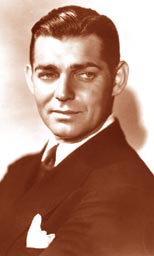|
Wednesday, September 25, 1991
`Gone With The Wind' Sequel: Some Things Should Just End
Published on
Seattle Times
By Debbie Sontag
This whole recycling thing has gone too far. Cans? OK. Bottles? Fine. Rhett and
Scarlett? Please. That's cultural pollution, pure and cynical.
When Scarlett, on page 1,037 of "Gone With the Wind," said tomorrow was another
day, I for one didn't read it as a cliffhanger. Some things should just end. Be
over. Die. No?
No. Regardless of whether we give a damn, the heirs of Margaret Mitchell are
not about to let their future profits go with the wind when the copyright on
the 1936 epic novel expires in the year 2011.
With the release today of "Scarlett: The Sequel to Margaret Mitchell's Gone
With the Wind" - catchy title, huh? - Old Tiny Waist will be fiddle-dee-deeing
her way back into American culture, this time, thank heavens, without yodeling
too much about her great love for "darkies."
Glory, glory, stifle your yawns, roast your yams, launder your hankies.
Margaret Mitchell may be dead, but the Mitchell family has hired Alexandra
Ripley, a writer of genteel historical fiction, to empurple the old South with
new prose about the infamous love triangle of Scarlett, Rhett and Ashley.
(Rumor has it the triangle turns octagonal, or worse, as lovers abound.)
All copies of "Scarlett: The Sequel" were under tight surveillance in giant,
regional "holding pens," waiting to be shipped out last night to bookstores.
A nine-page excerpt from "Scarlett: The Sequel" appeared last month in Life
magazine. It bodes ill for the other 759 pages. The tone is flat, timeless. The
prose is not purple enough; it's kind of lavender. The characters are like
holograms of the originals; their dialogue is a parody.
I'm not alone in dreading the arrival of the 768-page saga of love and choler
in the post-Confederacy, a story whose time has plainly come and gone.
Meet Jim Swords, a 43-year-old junior high school teacher who lives off Tara
Boulevard in Jonesboro, Ga. He owns a life-size velvet painting of Clark Gable
as Rhett Butler, a reviewer's copy of the original novel, an Estonian
translation and a hand mirror that once belonged to Peggy Mitchell.
Even he, president of the Tara Collectors Club, is not looking forward to this
frenzy of hype.
"I'm a diehard," says Swords. "I don't believe you should tamper with a
classic. I think they've overstepped their bounds. I think the Mitchell family
has just taken it to the bank."
Warner Books paid the Mitchells $4.5 million for the right to publish the
sequel. Ripley, chosen for the job by a committee of lawyers, got a $60,000
advance, less than she received for her novels "Charleston" and "New Orleans
Legacy." The Mitchell family will collect most of the royalties. With foreign
sales and film rights, however, Ripley still stands to get about $1 million.
That, of course, is a better deal than Margaret Mitchell ever got. Mitchell
received her first check, of $5,000, from MacMillan Publishing one month before
the book was released on June 30, 1936. And she was riding high.
"Gone With the Wind," the movie, has so eclipsed the book in popularity that
many don't realize that Mitchell would have done quite well, thank you, without
Hollywood. (Not that she minded the extraordinary $50,000 she got for film
rights.)
You have to wonder whether the hefty novel would have flown off the shelves if
Mitchell had kept her original title: "Tote the Weary Load."
In final version, however, Gone "With the Wind" sold a then-record 176,000
copies in its first three weeks. Within six months, sales hit 1 million. And a
year later, Mitchell was awarded the Pulitzer Prize.
Fifty-five years later, "Gone With the Wind" has sold 25 million copies. No,
make that 25,000,001. I bought one last week. And on rereading, I found the
first half of "Gone with the Wind" a real slog.
The "darkie" dialect was embarrassing. And the repeated descriptions of "grinnin'
Negroes, excited as always at a party," hungry for "that dish of hog entrails
so dear to Negro hearts" and for "watermelons enough to satiate" were offensive
and tedious.
At midpoint, though, about the time that Scarlett and Ashley finally kissed, I
found myself, despite myself, engrossed. I had finally succumbed to the drawl
and waltz of Mitchell's prose.
It's interesting that the tone of the book is distinct from that of the movie.
Mitchell didn't write a glorification of the Confederacy, of the Lost Cause.
Her plantations weren't decorated with white-columned mansions; they were big
farms. Her plantation owners weren't all bluebloods; they were a motley crew of
ethnic, self-made men. Her male leads, Rhett and Ashley, both thought the South
suicidal to fight the Civil War.
Mitchell's view of the economic causes and consequences of the Civil War was
fairly enlightened; her description of race relations was anything but.
According to "Southern Daughter," Florida International University professor
Darden Pyron's new biography of Mitchell, the famous author dropped out of a
history class at Smith College on discovering that one of the other students
was black.
"Gone With the Wind" is a period piece. It should be finite. To move it out of
its 1930s-1940s context into 1991 America is forced and crass. It's risky to
fool around with fixed images, with cultural icons.
"It will never hold a candle to the original," Swords says.
His prediction: "There will be a lot of hoopla and then it will be over. `Scarlett:
The Sequel' is never going to live on in the public imagination. You're never
going to see `Scarlett: The Sequel' perfume or `Scarlett: The Sequel' bedsheets."
Wanna bet?
|
